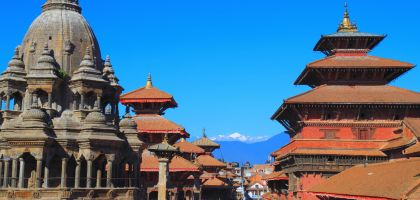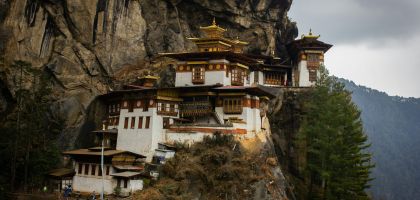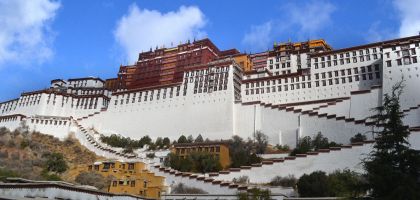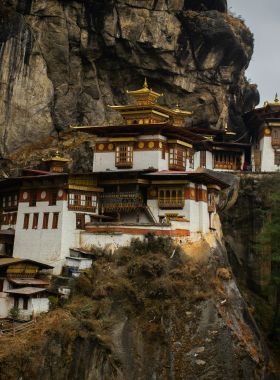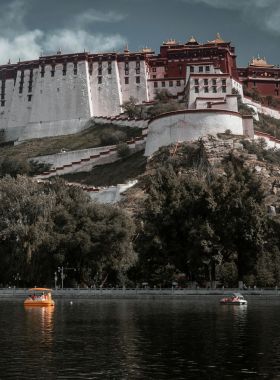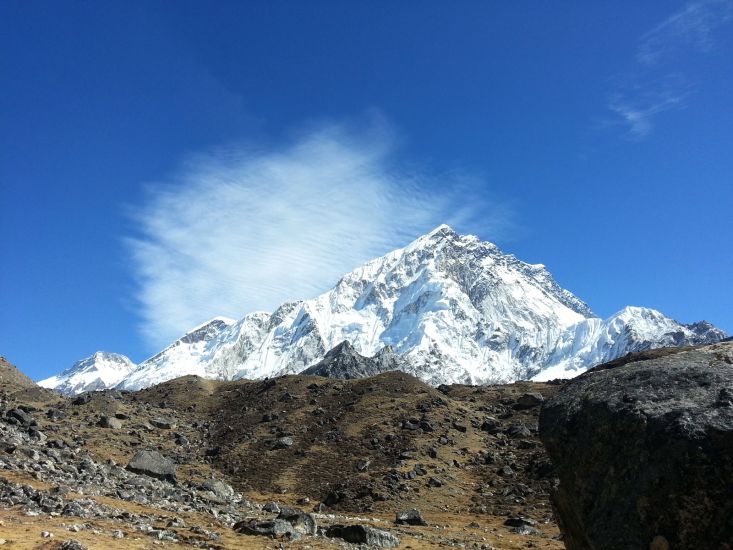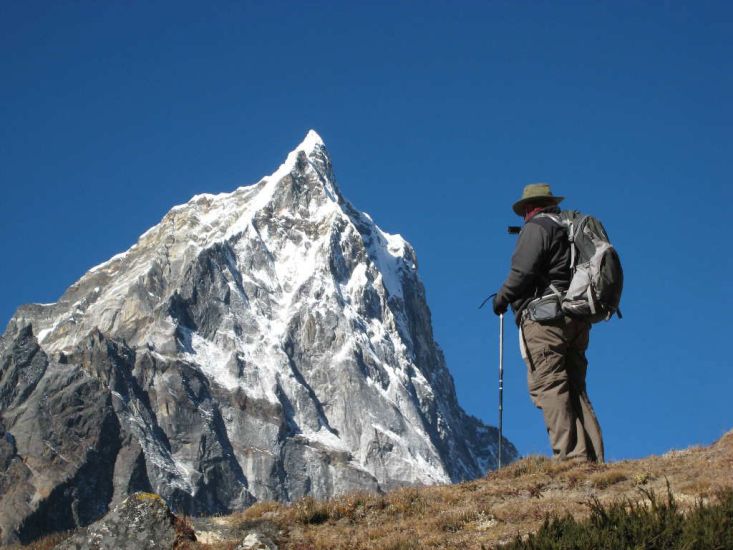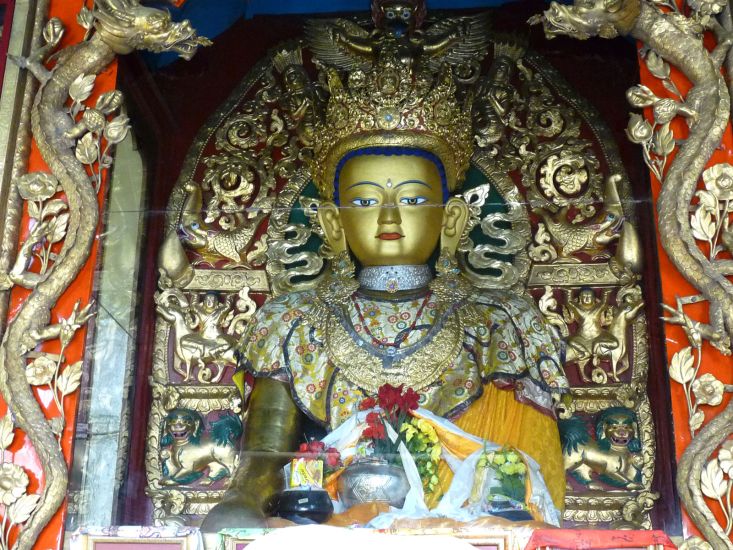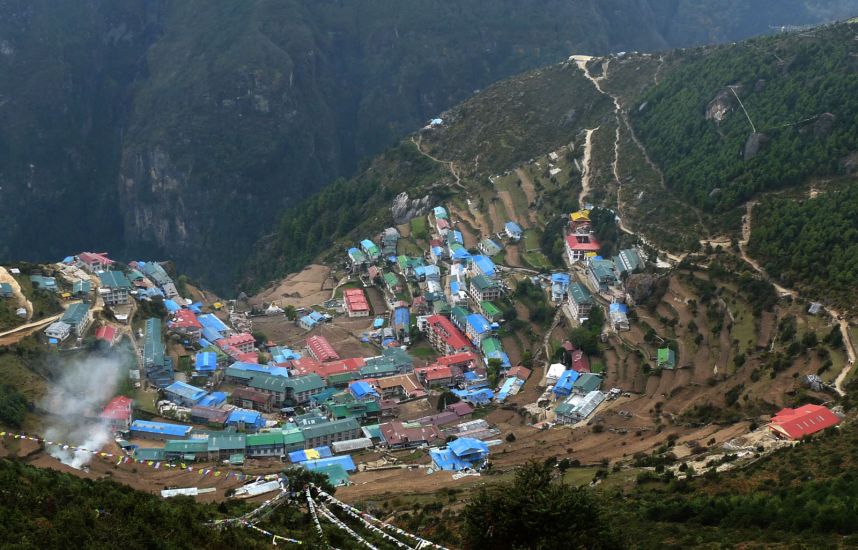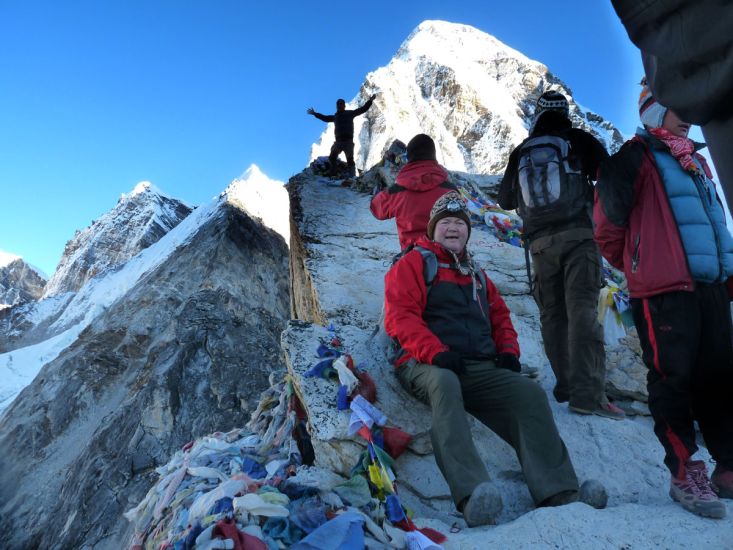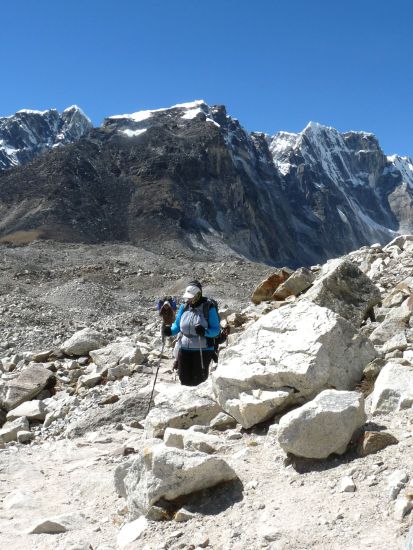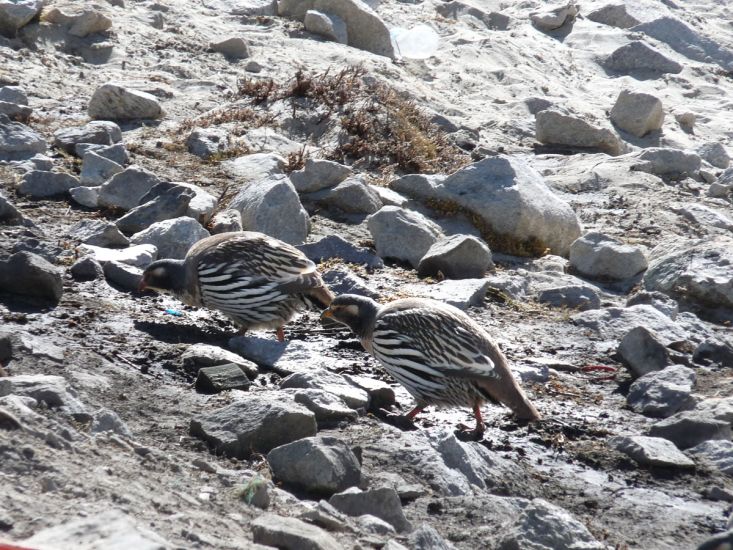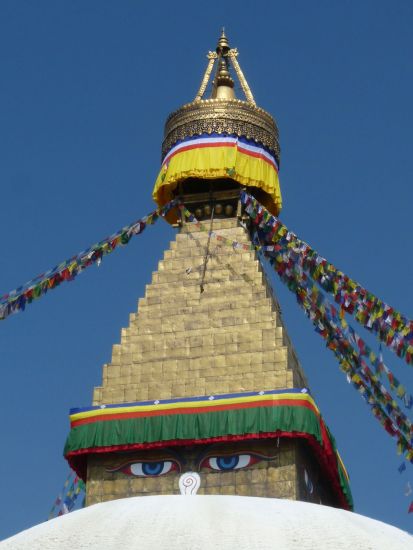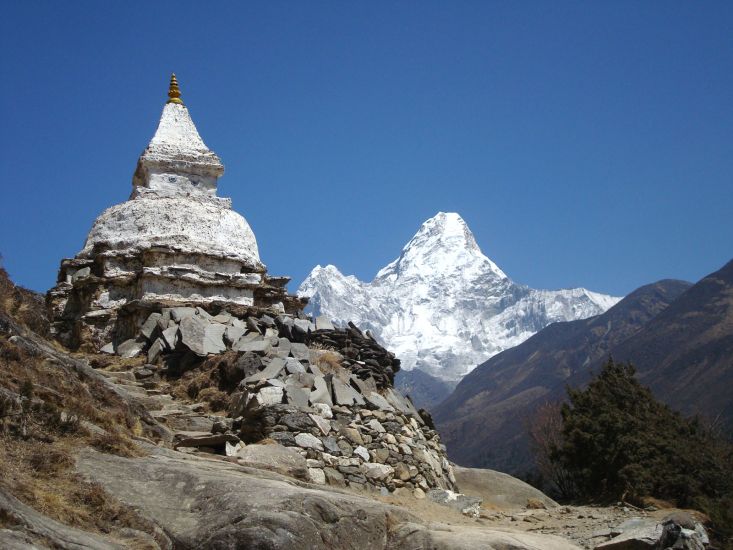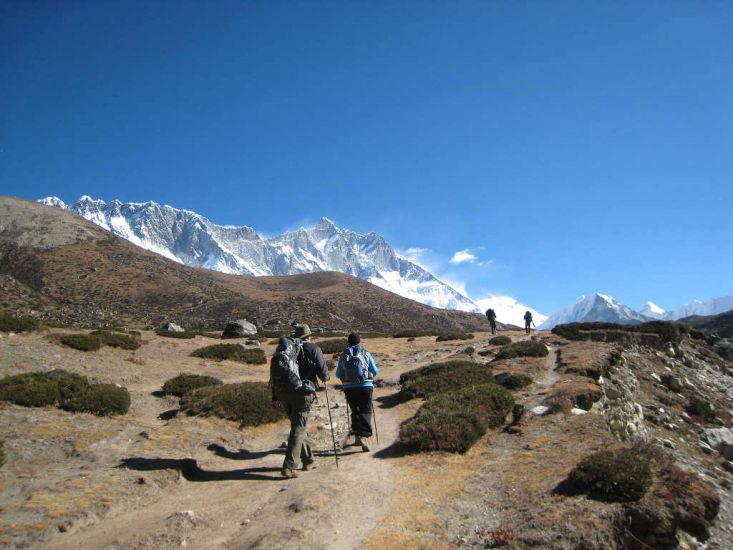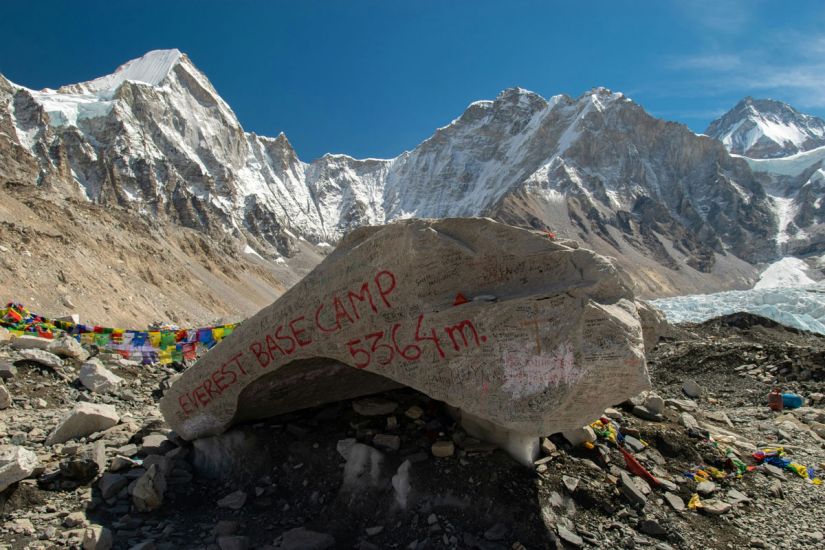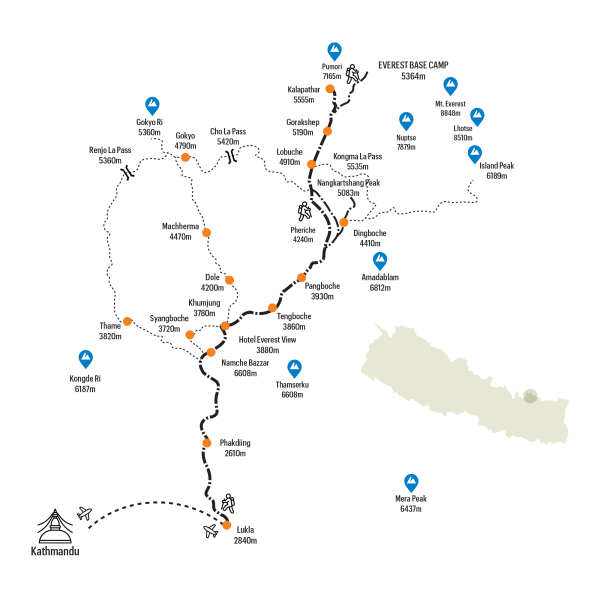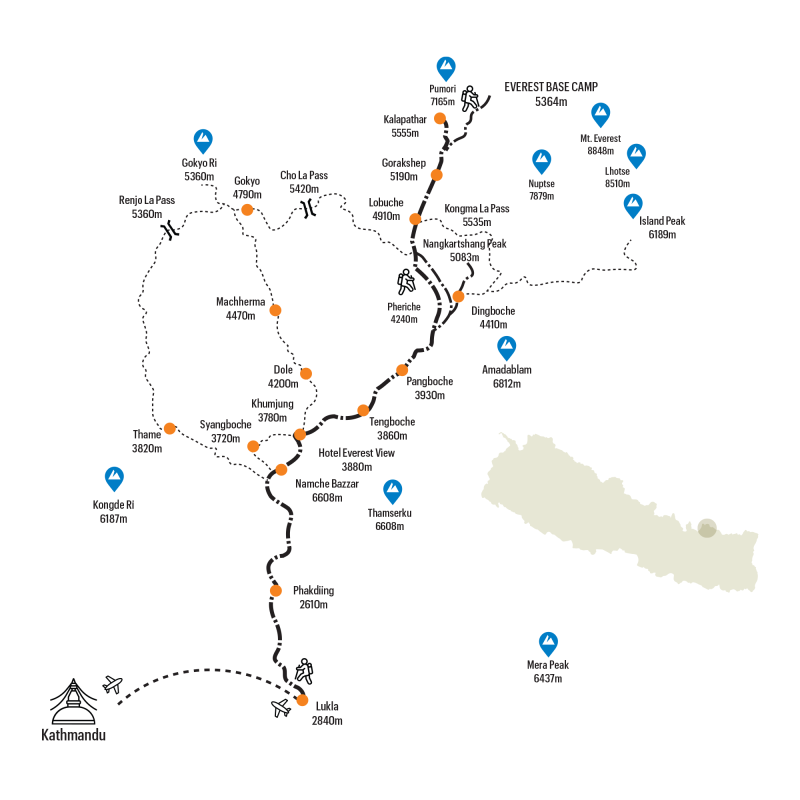Everest Base Camp Trek
14 Days / Nepal
Activity
Difficulty Level
Destinations
Trip Start / End
Max Altitude
Accommodation
Travel Style
Best time to travel
Personalized Travel Advice

Dev Raj Nepal
+977 9851096523
Personalized Travel Advice

Dev Raj Nepal
+977 9851096523
Detailed Itinerary
01
DAY
01
Your Everest Base Camp adventure begins with your arrival in Kathmandu, Nepal’s vibrant capital. A city rich in culture and history, Kathmandu offers a unique blend of ancient traditions and modern energy. Upon arrival, you will be transferred to your hotel, where you can relax and prepare for the trek ahead. If time allows, explore the bustling streets of Thamel, a hub for trekkers, or visit UNESCO-listed sites such as Boudhanath Stupa or Pashupatinath Temple. In the evening, a briefing with your trekking guide will ensure you are well-prepared for the journey ahead. Overnight at a hotel.
Arrival in Kathmandu
Your Everest Base Camp adventure begins with your arrival in Kathmandu, Nepal’s vibrant capital. A city rich in culture and history, Kathmandu offers a unique blend of ancient traditions and modern energy. Upon arrival, you will be transferred to your hotel, where you can relax and prepare for the trek ahead. If time allows, explore the bustling streets of Thamel, a hub for trekkers, or visit UNESCO-listed sites such as Boudhanath Stupa or Pashupatinath Temple. In the evening, a briefing with your trekking guide will ensure you are well-prepared for the journey ahead. Overnight at a hotel.
02
DAY
02
Depending on the season, you will either fly to Lukla directly from Kathmandu or take a scenic drive to Manthali (Ramechhap) in the early morning before catching a short flight. During peak trekking months — March, April, May, September, October, and November — flights are operated from Manthali Airport, which requires an early wake-up and a 5 to 6-hour drive from Kathmandu. In other months, flights typically operate directly from Kathmandu’s domestic airport. Our team will coordinate everything for you and ensure a smooth start to your journey. The short flight to Lukla offers breathtaking views of the Himalayas and sets the tone for your adventure.
After landing at one of the world’s most iconic mountain airstrips, you’ll meet your porters and begin your trek to Phakding. The Everest Base Camp trek begins today. The trail descends gently through pine forests and Sherpa villages, following the Dudh Koshi River. Crossing suspension bridges draped with prayer flags, you arrive in the riverside village of Phakding, surrounded by greenery and mountain charm. Overnight at a Tea House (Guest House) in Phakding.
Flight to Lukla -Trek to Phakding
Depending on the season, you will either fly to Lukla directly from Kathmandu or take a scenic drive to Manthali (Ramechhap) in the early morning before catching a short flight. During peak trekking months — March, April, May, September, October, and November — flights are operated from Manthali Airport, which requires an early wake-up and a 5 to 6-hour drive from Kathmandu. In other months, flights typically operate directly from Kathmandu’s domestic airport. Our team will coordinate everything for you and ensure a smooth start to your journey. The short flight to Lukla offers breathtaking views of the Himalayas and sets the tone for your adventure.
After landing at one of the world’s most iconic mountain airstrips, you’ll meet your porters and begin your trek to Phakding. The Everest Base Camp trek begins today. The trail descends gently through pine forests and Sherpa villages, following the Dudh Koshi River. Crossing suspension bridges draped with prayer flags, you arrive in the riverside village of Phakding, surrounded by greenery and mountain charm. Overnight at a Tea House (Guest House) in Phakding.
03
DAY
03
As you move onward, the trail reveals new alpine landscapes and traditional Sherpa villages. This is the heart of the Khumbu region. Walking through dense rhododendron and pine forests, you cross multiple high-suspension bridges, including the famous Hillary Suspension Bridge. As you ascend, the first glimpses of Everest come into view. The final stretch is a steep climb to Namche Bazaar, the lively trading hub of the Sherpa people. This vibrant town offers cozy teahouses, bakeries, and stunning mountain panoramas. Here, you settle in and begin adjusting to the altitude. Overnight at a Tea House.
Trek from Phakding to Namche Bazaar
As you move onward, the trail reveals new alpine landscapes and traditional Sherpa villages. This is the heart of the Khumbu region. Walking through dense rhododendron and pine forests, you cross multiple high-suspension bridges, including the famous Hillary Suspension Bridge. As you ascend, the first glimpses of Everest come into view. The final stretch is a steep climb to Namche Bazaar, the lively trading hub of the Sherpa people. This vibrant town offers cozy teahouses, bakeries, and stunning mountain panoramas. Here, you settle in and begin adjusting to the altitude. Overnight at a Tea House.
04
DAY
04
To aid acclimatization on the Everest Base Camp trek, you spend the day exploring Namche Bazaar, the vibrant Sherpa trading hub nestled at 3,440 meters.
A highlight is the hike to the Everest View Hotel, one of the highest-altitude hotels in the world, perched at around 3,880 meters. This gentle hike offers stunning panoramic views of Mount Everest, Lhotse, and Ama Dablam, providing an inspiring glimpse of the peaks you’ll be trekking towards on the Everest Base Camp trek. Along the way, you can visit the Sherpa Culture Museum to learn about the history and traditions of the local people or stop by the Namche Monastery to experience the spiritual side of the region.
After enjoying this amazing scenery and cultural insights, you return to Namche Bazaar to rest, acclimatize further, and prepare for the next leg of your Everest Base Camp trek. Overnight at a cozy tea house in Namche.
Acclimatization day in Namche Bazaar (Hike to Everest View Hotel)
To aid acclimatization on the Everest Base Camp trek, you spend the day exploring Namche Bazaar, the vibrant Sherpa trading hub nestled at 3,440 meters.
A highlight is the hike to the Everest View Hotel, one of the highest-altitude hotels in the world, perched at around 3,880 meters. This gentle hike offers stunning panoramic views of Mount Everest, Lhotse, and Ama Dablam, providing an inspiring glimpse of the peaks you’ll be trekking towards on the Everest Base Camp trek. Along the way, you can visit the Sherpa Culture Museum to learn about the history and traditions of the local people or stop by the Namche Monastery to experience the spiritual side of the region.
After enjoying this amazing scenery and cultural insights, you return to Namche Bazaar to rest, acclimatize further, and prepare for the next leg of your Everest Base Camp trek. Overnight at a cozy tea house in Namche.
05
DAY
05
Leaving Namche Bazaar behind, the route gradually rises through fragrant woodlands of pine and rhododendron, offering glimpses of snow-capped peaks along the way to Tengboche. Along the way, you will encounter stunning views of Mount Everest, Ama Dablam, and Thamserku. Tengboche is famous for its ancient Tengboche Monastery, the largest gompa in the Khumbu region, which holds great spiritual significance for the Sherpa people. Visiting the monastery offers a unique cultural experience and a moment of peace amid the rugged mountain landscape. The trail here combines natural beauty with rich cultural heritage, making this segment a highlight of the Everest Base Camp trek. Overnight at a tea house in Tengboche.
Trek from Namche Bazaar to Tengboche
Leaving Namche Bazaar behind, the route gradually rises through fragrant woodlands of pine and rhododendron, offering glimpses of snow-capped peaks along the way to Tengboche. Along the way, you will encounter stunning views of Mount Everest, Ama Dablam, and Thamserku. Tengboche is famous for its ancient Tengboche Monastery, the largest gompa in the Khumbu region, which holds great spiritual significance for the Sherpa people. Visiting the monastery offers a unique cultural experience and a moment of peace amid the rugged mountain landscape. The trail here combines natural beauty with rich cultural heritage, making this segment a highlight of the Everest Base Camp trek. Overnight at a tea house in Tengboche.
06
DAY
06
After a descent through wooded trails, the route ascends again into open alpine terrain, guiding you toward Pangboche, a traditional Sherpa village and the highest permanently inhabited settlement in the area. As you gain altitude, dense trees give way to shrubs and wide-open landscapes. Upon reaching Dingboche, a picturesque village surrounded by snow-capped peaks, you will notice a dramatic change in scenery. This village is an ideal spot to rest and acclimatize before ascending further on the Everest Base Camp trek. Overnight at a cozy tea house.
Trek from Tengboche to Dingboche
After a descent through wooded trails, the route ascends again into open alpine terrain, guiding you toward Pangboche, a traditional Sherpa village and the highest permanently inhabited settlement in the area. As you gain altitude, dense trees give way to shrubs and wide-open landscapes. Upon reaching Dingboche, a picturesque village surrounded by snow-capped peaks, you will notice a dramatic change in scenery. This village is an ideal spot to rest and acclimatize before ascending further on the Everest Base Camp trek. Overnight at a cozy tea house.
07
DAY
07
A crucial acclimatization day in Dingboche includes a rewarding hike to Nagarjun Hill, located just above the village. This steep but manageable climb is an important part of the Everest Base Camp trek, designed to help your body adapt to the high altitude and reduce the risk of altitude sickness. The effort is well worth it as at the summit, you are treated to sweeping panoramic views of some of the region’s most majestic peaks, including Makalu, the world’s fifth-highest mountain, as well as Lhotse and Ama Dablam.
Spending the day hiking at higher elevation but returning to a comfortable base allows your body to acclimatize naturally, improving your chances of a safe and successful trek. After soaking in the stunning mountain vistas and capturing memorable photos, you descend back to Dingboche to relax and prepare for the next stage of your journey. This day of active rest is essential for building stamina and adjusting to the unique challenges of the Himalayas. Overnight at a cozy tea house in Dingboche.
Acclimatization day in Dingboche (Hike to Nagarjun Hill)
A crucial acclimatization day in Dingboche includes a rewarding hike to Nagarjun Hill, located just above the village. This steep but manageable climb is an important part of the Everest Base Camp trek, designed to help your body adapt to the high altitude and reduce the risk of altitude sickness. The effort is well worth it as at the summit, you are treated to sweeping panoramic views of some of the region’s most majestic peaks, including Makalu, the world’s fifth-highest mountain, as well as Lhotse and Ama Dablam.
Spending the day hiking at higher elevation but returning to a comfortable base allows your body to acclimatize naturally, improving your chances of a safe and successful trek. After soaking in the stunning mountain vistas and capturing memorable photos, you descend back to Dingboche to relax and prepare for the next stage of your journey. This day of active rest is essential for building stamina and adjusting to the unique challenges of the Himalayas. Overnight at a cozy tea house in Dingboche.
08
DAY
08
Continuing towards Lobuche, the trail passes through the windswept Thukla Pass, where you will find memorials dedicated to climbers who lost their lives on Everest. The terrain becomes more rugged as you approach Lobuche, a small settlement nestled beneath towering peaks. The air is thinner here, and temperatures drop, signaling that you are nearing the Everest Base Camp. Overnight at a Tea House.
Trek from Dingboche to Lobuche
Continuing towards Lobuche, the trail passes through the windswept Thukla Pass, where you will find memorials dedicated to climbers who lost their lives on Everest. The terrain becomes more rugged as you approach Lobuche, a small settlement nestled beneath towering peaks. The air is thinner here, and temperatures drop, signaling that you are nearing the Everest Base Camp. Overnight at a Tea House.
09
DAY
09
Today is the most anticipated day of the trek. A challenging yet rewarding hike takes you to Gorakshep, the last settlement before Everest Base Camp. After a brief stop, you continue towards Everest Base Camp, traversing rocky moraines and glacial paths. Reaching base camp is a surreal experience—standing at the foot of the world’s highest peak, surrounded by towering ice formations and prayer flags. After soaking in the views, you return to Gorakshep for the night. Overnight at a Tea House.
Trek to Gorakshep – Everest Base Camp. Return to Gorakshep
Today is the most anticipated day of the trek. A challenging yet rewarding hike takes you to Gorakshep, the last settlement before Everest Base Camp. After a brief stop, you continue towards Everest Base Camp, traversing rocky moraines and glacial paths. Reaching base camp is a surreal experience—standing at the foot of the world’s highest peak, surrounded by towering ice formations and prayer flags. After soaking in the views, you return to Gorakshep for the night. Overnight at a Tea House.
10
DAY
10
Before dawn, you begin your climb to Kala Patthar, the highest point of the trek. The ascent is steep, but the reward is an unforgettable sunrise over Everest, casting golden hues on the peaks. After capturing breathtaking photographs, you descend back to Gorakshep for breakfast before trekking down to Pheriche, where the thicker air makes for a more comfortable rest. Overnight at a Tea House.
Hike to Kala Patthar for Sunrise – Descend to Pheriche (4,210m)
Before dawn, you begin your climb to Kala Patthar, the highest point of the trek. The ascent is steep, but the reward is an unforgettable sunrise over Everest, casting golden hues on the peaks. After capturing breathtaking photographs, you descend back to Gorakshep for breakfast before trekking down to Pheriche, where the thicker air makes for a more comfortable rest. Overnight at a Tea House.
11
DAY
11
As you continue your descent, the landscape begins to shift, snow-dusted peaks give way to dense forests and winding rivers. Retracing your steps through familiar trails feels different this time, marked by a deep sense of accomplishment. Upon reaching Namche Bazaar, the lower altitude offers welcome relief. The vibrant energy of the town, the comfort of a warm meal, and the chance to reconnect with fellow trekkers make it a special return. This is a moment to reflect on the challenges you’ve overcome and the memories you’ve gathered along the way. Overnight at a Tea House.
Trek from Pheriche to Namche Bazaar
As you continue your descent, the landscape begins to shift, snow-dusted peaks give way to dense forests and winding rivers. Retracing your steps through familiar trails feels different this time, marked by a deep sense of accomplishment. Upon reaching Namche Bazaar, the lower altitude offers welcome relief. The vibrant energy of the town, the comfort of a warm meal, and the chance to reconnect with fellow trekkers make it a special return. This is a moment to reflect on the challenges you’ve overcome and the memories you’ve gathered along the way. Overnight at a Tea House.
12
DAY
12
Your final trekking day takes you back to Lukla. Passing through forests, suspension bridges, and Sherpa villages, you soak in the last glimpses of the Khumbu region. Upon arrival in Lukla, you celebrate your achievement with your team before a well-earned rest. You Everest Base Camp trek ends here. We will return to Kathmandu, the next day. Stay for the night at a Tea House or Lodge in Lukla.
Trek from Namche Bazaar to Lukla
Your final trekking day takes you back to Lukla. Passing through forests, suspension bridges, and Sherpa villages, you soak in the last glimpses of the Khumbu region. Upon arrival in Lukla, you celebrate your achievement with your team before a well-earned rest. You Everest Base Camp trek ends here. We will return to Kathmandu, the next day. Stay for the night at a Tea House or Lodge in Lukla.
13
DAY
13
A scenic flight returns you to Kathmandu, where you can unwind and explore the city. You may choose to walk around Thamel, the tourist hub of Kathmandu or visit cultural and historical landmarks, shop for souvenirs, or enjoy a celebratory meal. Overnight at a hotel.
Flight from Lukla to Kathmandu
A scenic flight returns you to Kathmandu, where you can unwind and explore the city. You may choose to walk around Thamel, the tourist hub of Kathmandu or visit cultural and historical landmarks, shop for souvenirs, or enjoy a celebratory meal. Overnight at a hotel.
14
DAY
14
After an unforgettable journey to Everest Base Camp, it’s time to bid farewell to Nepal. Depending on your schedule, you may have time for last-minute explorations before heading to the airport for your departure.
Departure
After an unforgettable journey to Everest Base Camp, it’s time to bid farewell to Nepal. Depending on your schedule, you may have time for last-minute explorations before heading to the airport for your departure.
Tour Cost
At High Asia Tours, we know that understanding tour costs is essential for planning your trip. Due to variables such as accommodation choices, meal plans, transportation options, group size, and seasonal demand, providing an exact price upfront is challenging.
To assist you, we offer a starting price to give a general idea of the cost:
The starting cost for this tour is
Includes / Excludes
Inclusions
-
All transfers on a tourist vehicle
-
All accommodations on a twin sharing basis
-
All meals mentioned in the itinerary
-
Experienced local guide and porters
-
Permits for Sagarmatha/Everest National Park and TIMS (Trekkers’ Information Management System)
-
All domestic flights
Exclusions
-
Meals not mentioned
-
International flight fare and airport departure tax
-
Any alcoholic beverages
-
Travel insurance along with high-altitude emergency evacuation coverage
-
Tips to trekking staff and driver
-
Nepal Entry Visa
-
Personal Trekking gear and equipment
Trip Info
Everest Base Camp is a place of stone, ice, and silence. The air is thin, and the wind never rests. Around you, the Khumbu Glacier creaks and shifts, its surface gray with dust and ancient ice. Bright tents lie scattered across the moraine, a patchwork of color against the pale earth. The smell of kerosene and snow fills the air.
You stand at 5,364 meters, where every breath feels earned. Above you, the summit of Everest hides behind the ridges, but its presence is everywhere, in the cold, in the stillness, in the faces of those who made it here. You can see the Lhotse Face gleaming in the sun, Nuptse rising like a wall beside it, and the flutter of prayer flags strung between cairns left by trekkers before you.
There is no sound but the wind and the quiet murmur of people who have walked far to reach this place. Some smile, some weep, some stand silent. You look up at the sky, and it feels close enough to touch. For a moment, everything is clear, the height, the effort, the dream that brought you here. Then the wind moves again, and you start the long walk back.
Everest Base Camp Trek
The Everest Base Camp Trek is one of the most iconic adventures in the world. Each year, thousands of trekkers travel to Nepal to follow the trail to the base of Mount Everest, the highest mountain on Earth. The journey begins in the foothills and climbs through forests, glacial valleys, and high alpine terrain.
Trekkers pass through Sherpa villages, visit ancient monasteries, and walk beneath the towering peaks of the eastern Himalayas. The air grows thinner with each step, and the scenery becomes more dramatic. Reaching Everest Base Camp at 5,364 meters is a powerful moment for anyone who makes the journey.
The Everest Base Camp Trek is about walking through a landscape shaped by time and belief. Snow-covered peaks rise above quiet villages where prayer wheels spin in the wind. Yaks carry supplies along stone-paved trails, and the sound of footsteps blends with the rhythm of mountain life.
Along the way, there are moments of reflection, challenge, and awe. Trekkers feel a deep connection with the land and the people who call it home. Everest Base Camp trek offers a raw and unforgettable experience in one of the most breathtaking regions on the planet.
The Everest Base Camp Trek is a demanding adventure that calls for preparation, stamina, and a strong sense of purpose. It is suited for travelers who are comfortable walking for several hours a day, sometimes uphill, and at high altitudes. While you do not need technical climbing skills, you should be in good physical health and mentally prepared for changing weather, basic mountain accommodation, and limited comforts. The trek reaches elevations over 5,000 meters, so understanding the effects of altitude is important. People of various ages and backgrounds have completed this journey successfully with proper pacing and guidance.
If you enjoy walking in remote landscapes, learning about different cultures, and setting personal goals, this trek offers something deeply rewarding. The route follows a well-established path through villages, forests, and open alpine terrain. Each day reveals new scenery and opportunities to meet local people or connect with fellow trekkers. Whether you are seeking a physical challenge or a meaningful journey, the Everest Base Camp Trek offers a chance to experience the Himalayas in a way that stays with you long after the trail ends.
The best time to embark on the Everest Base Camp Trek is during the spring (March to May) and autumn (September to November) seasons, offering ideal weather conditions and breathtaking views.
Spring (March to May): Spring is one of the most favored seasons for trekking in Nepal. The weather during this time is relatively mild, with daytime temperatures ranging from 10°C to 15°C (50°F to 59°F) at lower altitudes, and cooler temperatures at higher elevations. The skies are clear, providing spectacular views of the snow-capped peaks. This is also the time when rhododendrons, orchids, and other wildflowers bloom, creating a colorful contrast against the rugged terrain. While the weather is favorable, the trails may be a bit busier as it is peak trekking season, but the vibrant energy of fellow trekkers adds to the experience.
Autumn (September to November): Autumn is considered the best overall time for the Everest Base Camp Trek. The monsoon rains have just ended, leaving the air crisp, clean, and clear, making it perfect for mountain views. The temperature during the day is comfortable, ranging from 5°C to 15°C (41°F to 59°F), while nights can be chilly, especially at higher altitudes. This season is less crowded than spring, but still sees a steady flow of trekkers, offering a more peaceful trekking experience. The clear skies and breathtaking views of the Himalayas make this an excellent time for photography and enjoying panoramic vistas. Additionally, this is the festival season in Nepal, and you may be able to witness cultural celebrations, adding an extra layer of immersion to your journey.
Clothing & Footwear
- Waterproof and breathable jacket and pants
- Insulating layers (fleece, down jacket)
- Thermal base layers
- Hiking pants and shorts
- Warm hat and sun hat
- Gloves
- Warm socks
- Sturdy, waterproof hiking boots
- Comfortable sandals or shoes
Gear & Accessories
- Backpack (50-70 liters)
- Sleeping bag (rated for cold temperatures)
- Trekking poles
- Headlamp with extra batteries
- Sunglasses
- Sunscreen and lip balm
- Water bottles or hydration system
- Water purification tablets or filter
- Toiletries
- Quick-dry towel
Remember to pack light and efficiently.
Food on the Everest Base Camp Trek offers a delightful mix of traditional Nepali and Tibetan cuisine, providing trekkers with local flavors and ingredients.
Dal Bhat, a hearty and nutritious meal consisting of rice, lentil soup, and vegetables, is a staple in Nepali trekking cuisine and is often served multiple times a day. It’s usually accompanied by a side of pickle for extra flavor.
Momo, steamed or fried dumplings filled with meat or vegetables, are a popular snack or lunch option along the trail. For breakfast, Tibetan bread, a type of flatbread served with butter or jam, is commonly enjoyed, providing energy for the day ahead.
Warm soups, such as vegetable soup, noodle soup, or thukpa (a Tibetan noodle soup), are common, offering comfort and warmth, especially in the colder regions. Most restaurants also offer Nepali Ramen, such as, Waiwai which is a flavorful comfort good.
In Kathmandu, the accommodations are more modern and comfortable, with a range of hotels available that cater to different budgets. You can expect private rooms with en-suite bathrooms, hot showers, and other amenities like Wi-Fi and room service, providing a relaxing stay before and after your trek.
In the higher-altitude regions of the Everest region, accommodations consist of guesthouses, which are simple, family-run lodges that provide a place to sleep, meals, and a warm environment. Guesthouses are basic but functional, with rooms typically featuring twin beds, wooden floors, and a blanket for warmth. Some guesthouses may offer additional amenities such as hot water (for a fee) or charging facilities, though this varies from place to place. Though the accommodations in the teahouses can be simple, they are a fundamental part of the trekking experience, allowing trekkers to connect with the local culture and landscape while enjoying the warmth and hospitality of the local people.
Guide
A great trek is only as good as the people who walk beside you. Our Everest Base Camp Trek is led by experienced, licensed local guides who know the region intimately, from the mountain peaks to the monastery bells. They are trained in altitude awareness, first aid, and high-altitude safety. More importantly, they bring the trail to life with stories, cultural insights, and a deep connection to the landscape.
Porters
Porters are the backbone of Himalayan trekking. They carry your duffel bags across stone steps and suspension bridges, making your journey more manageable. For the Everest Base Camp trek, the typical ratio is one porter for every two trekkers. Each porter carries a combined load of about 20 to 25 kilograms, which means around 10 to 12 kilograms per trekker. This balanced system ensures that porters are not overburdened and that you have the support you need throughout the journey.
We follow ethical porter standards, including fair wages, proper equipment, load limits, and insurance coverage. Trekking with a local team means you are guided and supported by people who grew up in the region and know its rhythm, trails, and traditions.
Risks of the Everest Base Camp Trek
Altitude Sickness (AMS)
The most significant risk is reduced oxygen levels at high elevations. Symptoms include headache, dizziness, nausea, and fatigue. These can range from mild discomfort to severe illness that may require descent or evacuation. Acclimatization days are built into the itinerary, but awareness and self-monitoring are essential.
Weather Fluctuations
The Himalayas experience sudden changes in weather, including snowstorms, high winds, and sub-zero temperatures. Poor weather can affect visibility and trail safety, especially at higher altitudes.
Rugged Terrain
The trail includes steep, rocky, and sometimes slippery sections. There is a risk of sprained ankles or falls, so trekking poles and sturdy footwear are recommended.
Physical and Mental Fatigue
Long days walking at altitude can cause exhaustion. Proper physical preparation, pacing, hydration, and rest are critical for a safe trek.
Rewards of the Everest Base Camp Trek
Incredible Mountain Views
Panoramic vistas of Mount Everest, Lhotse, Ama Dablam, and other iconic peaks create unforgettable moments throughout the trek.
Reaching Base Camp
Standing at the foot of the world’s highest peak offers a profound sense of achievement and fulfillment.
Cultural Experiences
Engaging with Sherpa communities and visiting monasteries adds rich spiritual and cultural depth to the journey.
Personal Growth
Overcoming the physical and mental challenges builds resilience and creates a lasting connection with nature.
Lasting Memories
The combination of natural beauty, cultural richness, and personal triumph makes the trek a life-changing adventure.
To join the Everest Base Camp Trek, all foreign travelers (except citizens of India) need a Nepal tourist visa. You can easily obtain a visa on arrival at Tribhuvan International Airport in Kathmandu or apply online through Nepal’s official immigration website. The most common option for trekkers is a 15-day visa, which gives you enough time for the trek and a few days of buffer on either side. Make sure your passport is valid for at least six months from your date of entry. The visa fee, which is USD 30/- for 15 days is not included in your package.
Trekking Permits Required
Sagarmatha National Park Entry Permit: This permit is needed to enter Sagarmatha National Park, a UNESCO World Heritage Site that protects the unique Himalayan environment surrounding Mount Everest. The fee supports conservation efforts in the region. The cost is approximately NPR 3,000 per person for foreign trekkers. It can be obtained in Kathmandu or at park entry points such as Lukla or Monjo. For more information check NTB.
Khumbu Pasang Lhamu Rural Municipality Permit: Issued by the local government of the Khumbu region, this permit helps fund community development and maintain trekking trails and infrastructure. The fee is NPR 2,800 per person for the first four weeks, and NPR 3,500 if staying longer. It can be obtained upon arrival in Lukla or Monjo. For more information check Nepal Government Immigration.
We Handle All Permits for You
When you book the Everest Base Camp Trek with us, we arrange both permits for you. You don’t need to stand in queues or manage the paperwork. All permit fees are included in your package so you can focus on enjoying your trek.
The Everest Base Camp Trek reaches a maximum elevation of 5,364 meters (17,598 feet) at the base camp itself, with the highest sleeping point being Gorakshep at 5,140 meters (16,864 feet). At these altitudes, the oxygen level is significantly lower than at sea level, and some people may begin to feel the effects of altitude sickness. Common symptoms include headaches, loss of appetite, dizziness, and difficulty sleeping. That’s why acclimatization is one of the most important parts of this trek.
Our Everest Base Camp Trek itinerary is designed with proper acclimatization in mind. We include two scheduled rest and acclimatization days — one in Namche Bazaar (3,440 meters) and another in Dingboche (4,410 meters). These extra days allow your body to gradually adapt to the thinning air and help reduce the risk of Acute Mountain Sickness (AMS). We always encourage trekkers to walk slowly, stay hydrated, and listen to their bodies. Our experienced guides are trained to recognize early symptoms of altitude issues and will adjust the pace or itinerary if necessary to prioritize your safety. If needed, we can also assist with oxygen or arrange emergency evacuation through your travel insurance provider.
Is the Flight to Lukla Safe?
The flight to Lukla is an unforgettable part of the Everest Base Camp Trek. It takes you from the lowlands of Nepal into the heart of the Himalayas in less than an hour, offering stunning aerial views of mountain peaks, deep valleys, and terraced hillsides. The plane lands at Tenzing-Hillary Airport in Lukla (2,840 m), one of the most famous high-altitude airstrips in the world, known for its short runway and dramatic location on a mountain slope. While it is often described as thrilling, Lukla Airport is managed by experienced pilots who specialize in mountain flying and operate under strict safety protocols.
During peak trekking months ( March, April, May, September, October, and November ) flights are rerouted from Ramechhap/Manthali Airport instead of Kathmandu to ease air traffic congestion. This requires a drive of 5 to 6 hours from Kathmandu in the early morning, usually starting extremely early in the morning. The best way to cope with this is either allocate an extra day in Kathmandu and travel to Ramechhap in the evening or arrive in Kathmandu and directly move to Ramechhap. However, this conundrum can be resolved after you make contact with us. During non-peak seasons (January, February, June, July, August, and December), flights generally depart directly from Kathmandu Domestic Airport. Flight duration from Manthali is about 20 minutes, while from Kathmandu it is about 35 minutes.
Weather in the mountains can be unpredictable, and occasional flight delays or cancellations may occur due to cloud cover, wind, or low visibility. These decisions are made with passenger safety as the top priority. We monitor weather conditions closely and stay in direct contact with airlines. In the event of a delay, we will assist you with rescheduling, and if necessary, arrange alternate options such as helicopter transport on request. Our team ensures that your journey begins with confidence and that you are well informed every step of the way.
Fitness and Preparation
The Everest Base Camp Trek does not require technical climbing skills, but it does demand good physical condition. You’ll be walking 5 to 7 hours a day on varied terrain, often uphill and at high altitudes. We recommend starting a training routine at least 6–8 weeks before your trek, focusing on cardio, stamina, and leg strength. Regular hiking with a loaded daypack, stair climbing, or hill walking can help your body adjust to the physical demands of the trail.
Trekking Pace and Walking
There is no need to rush. A steady, gradual pace is key to successful acclimatization. Our itineraries are designed to allow enough time for both walking and rest. Short breaks, slow ascents, and plenty of hydration make a big difference at higher elevations. Trekking poles can be helpful, especially on descents and rocky sections.
Water Safety and Hydration
Everest Base Camp Trek takes you to high altitudes. Therefore, staying hydrated is essential. You should aim to drink at least 3 to 4 liters of water per day. Bottled water is available in most villages, but we recommend using refillable bottles with purification tablets or filtration systems to reduce plastic waste and save money. Some lodges offer boiled water for a small fee. We provide guidance on safe water practices throughout the trek.
Cash and ATMs
There are no ATMs beyond Namche Bazaar, and credit cards are not accepted on the trail. Bring enough Nepali rupees in small denominations to cover your personal expenses such as snacks, Wi-Fi, hot showers, or charging fees. We recommend withdrawing cash in Kathmandu before the trek. Namche Bazaar has a couple of ATMs, but they are not always reliable.
Wi-Fi, Charging, and Connectivity
Wi-Fi is available at many teahouses, especially in Namche, Dingboche, and Lukla, but it usually comes at an extra cost and can be slow or unreliable at higher altitudes. We can also provide you with a local SIM card (NCELL or NTC) in Kathmandu for limited mobile data access in some areas. Charging electronic devices is available in most teahouses for a fee. Bring a power bank and solar charger if possible.
Showers and Hygiene
Hot showers are available at many lodges for an extra charge, especially in lower villages like Phakding, Namche, and Tengboche. At higher altitudes, showers may not be available or may be limited to bucket-style washing. Wet wipes, dry shampoo, and hand sanitizer are useful for maintaining hygiene during the trek. Basic shared toilets are the norm, and it’s a good idea to carry your own toilet paper and soap or sanitizer.
Stunning Himalayan Scenery
The Everest Base Camp Trek offers some of the most incredible scenery you’ll ever experience. As you hike through the Khumbu region, you’ll be treated to spectacular views of iconic peaks such as Mount Everest, Lhotse, Nuptse, and Ama Dablam. The terrain varies from lush valleys filled with dense rhododendron forests to high-altitude landscapes with rocky moraines, glacial rivers, and snow-capped mountains. Every day on the trail presents an opportunity to take in new vistas that will leave you speechless.
Sherpa Hospitality and Cultural Immersion
Along the route, you’ll immerse yourself in the vibrant Sherpa culture. The Sherpa people, known for their mountaineering skills, will welcome you with open arms as you pass through their charming villages. You’ll stay in traditional teahouses, where you’ll enjoy local cuisine and experience Sherpa warmth and hospitality. Don’t miss visiting the iconic Tengboche Monastery, a serene and sacred site offering both spiritual and cultural insight into the region. The opportunity to engage with locals and learn about their Buddhist traditions adds a deeply enriching dimension to your adventure.
Altitude Challenges and Acclimatization
Everest base camp trek presents both physical and mental challenges. As you ascend, the air gets thinner, and your body must adjust to the decreased oxygen levels. Acclimatization is key, and the trek is designed to help you gradually adapt with stops in places like Namche Bazaar and Dingboche. You’ll take it slow to allow your body time to acclimate, but be prepared for symptoms of altitude sickness like headaches or fatigue. Rest days, like the acclimatization day in Namche Bazaar, help minimize risks and prepare you for the final push to Base Camp.
Challenging Yet Rewarding Trails
The Everest base camp trek is not for the faint-hearted. You can expect long, challenging days of trekking over steep inclines and rocky terrain, with some days requiring tough ascents or descents. You’ll cross several suspension bridges over rushing rivers and make your way through thick forests and exposed ridges. However, the physical effort is well worth it. The feeling of achievement as you reach Base Camp and stand beneath the towering Everest is indescribable, and the effort you put into reaching that point will make it all the more rewarding.
Unpredictable Weather
While spring (March to May) and autumn (September to November) are the best times to trek, the weather in the Himalayas is notoriously unpredictable. Be prepared for sudden changes in temperature, ranging from the warmth of the lower valleys to the freezing cold of high altitudes. Rain or snowfall may catch you off guard, particularly in the more exposed parts of the trail. Ensure you have the right gear, including layers to keep you warm, waterproof clothing, and good-quality hiking boots to stay comfortable no matter the weather conditions.
Memorable Encounters with Fellow Trekkers
One of the joys of the Everest Base Camp trek is the community of trekkers you’ll meet along the way. You’ll share stories, advice, and encouragement with fellow adventurers from all corners of the globe. Whether you’re resting in a teahouse or trekking alongside someone on the trail, these shared experiences foster a unique sense of camaraderie. The journey, though challenging, becomes easier with the support of those around you, and you’ll find yourself forging bonds that last far beyond the trek itself.
Spiritual and Peaceful Atmosphere
The region surrounding Everest is not only breathtaking but also spiritually enriching. As you walk through the peaceful landscapes, you’ll pass countless Buddhist prayer flags, mani stones, and chortens (stupas). The sound of prayer wheels spinning and the sight of monasteries tucked into mountain slopes create a tranquil and meditative environment. The air feels charged with the sacred energy of the region, especially as you approach high-altitude sites like Tengboche Monastery. The peaceful atmosphere offers moments of reflection and serenity, helping you connect deeply with the journey.
A Sense of Accomplishment
The final push to Everest Base Camp and Kala Patthar is the culmination of your trek. Reaching Base Camp itself is a milestone—standing at the foot of the world’s highest peak, surrounded by glaciers and towering ice walls. The sense of accomplishment is immense, and you’ll feel a deep connection to the mountains that few people ever experience. The views from Kala Patthar, a short but steep hike from Base Camp, provide panoramic vistas of Everest and its neighboring peaks, making it one of the most spectacular views in the world. This trek is a physical challenge, but the reward—both in terms of scenery and personal achievement—makes it one of the most unforgettable experiences of a lifetime.
Everest Base Camp Trek takes you to a land rich in Sherpa culture, Buddhist heritage, and fragile mountain ecosystems. Being a responsible traveler helps preserve these communities and landscapes for future generations. Respecting local customs, minimizing environmental impact, and supporting the local economy are all part of a meaningful trekking experience.
When visiting monasteries and sacred sites, dress modestly and remove your shoes before entering. Always walk clockwise around stupas, mani walls, and prayer wheels, following local tradition. Ask for permission before taking photos of people, especially monks or elderly villagers. On the trail, greet locals with a friendly “Namaste” and give right of way to porters, yaks, and mules carrying heavy loads. Avoid touching prayer flags or stepping over religious objects.
Water is a precious resource in high-altitude villages. Most water used for showers, laundry, and cooking must be carried or boiled, so we encourage travelers to use water sparingly. Take short showers, avoid frequent laundry, and carry biodegradable soap and toiletries to minimize pollution. Wet wipes and a simple hygiene routine can go a long way without placing extra strain on local resources.
We also encourage trekkers to carry reusable water bottles, avoid plastic waste, and leave no litter behind. Staying in locally owned teahouses, buying directly from village shops, and tipping porters and guides fairly are simple ways to give back. Everest base camp trek is not only about the mountains, but also about honoring the people who call them home.
The mountain ecosystem is fragile. Please avoid picking wildflowers or plants, even those that seem abundant may play a crucial role in the local environment or hold cultural or medicinal significance. Leave nature as you found it, so others can experience its untouched beauty too.
Everest Base Camp Trek with a Local Tour Operator
Everest Base Camp Trek is a once-in-a-lifetime experience, and going with a trusted local operator can make all the difference. Here’s why many travelers choose to trek with a Nepali-based team:
Sustainability That Matters
Booking with a local operator directly supports the mountain communities you walk through. We employ local guides, porters, and support staff, stay in family-run teahouses, and contribute to conservation efforts through park permits and community fees. Your Everest base camp trek helps maintain trails, protect the fragile Himalayan ecosystem, and empower the people who live in its shadow.
Affordable
Trekking with a local company is often more affordable than booking through international agents, with no compromise on quality. Your money goes directly into the services you receive, rather than passing through layers of middlemen. That means better prices, transparent costs, and fair wages for the people who make your trek possible.
Tailored to You
Whether you want a slower pace, a side trip to Gokyo, or upgraded lodges along the route, local tour operators can customize the itinerary to fit your goals and fitness level. From dietary preferences to added acclimatization days, we adapt the trek around your comfort and needs.
Real Insight, Real Connections
Local guides offer more than directions, they share stories, rituals, and mountain traditions. You’ll get a deeper understanding of Sherpa culture, Buddhist heritage, and life in the Khumbu, turning your journey into something more than just a hike.
Reliable Support, Every Step
We arrange everything from airport transfers and permits to domestic flights and accommodation. In the mountains, our team monitors your health, handles logistics, and ensures your safety. Do your Everest base camp trek with peace of mind, knowing someone local is always looking out for you.
For more information on us, check Why Us
FAQs
Personalized Travel Advice

Dev Raj Nepal
+977 9851096523
